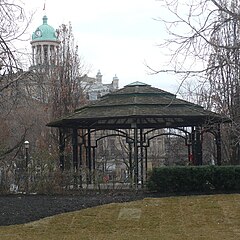St. James' Cathedral (Toronto)
| Cathedral Church of St. James | |
|---|---|

View of St. James and sign
|
|
| Coordinates: 43°39′01″N 79°22′26″W / 43.65028°N 79.37389°W | |
| Location | Toronto, Ontario |
| Country | Canada |
| Denomination | Anglican Church of Canada |
| Churchmanship | High church |
| Website | www.stjamescathedral.on.ca |
| History | |
| Dedication | Saint James |
| Administration | |
| Deanery | St James |
| Diocese | Toronto |
| Province | Ontario |
| Clergy | |
| Dean | Andrew Asbil |
| Subdean | David Brinton |
| Assistant priest(s) | Walter Hannam, Vicar of St Bartholomew's |
| Asst Curate(s) | Simon Davis |
| Laity | |
| Director of music | Robert Busiakiewicz |
| Organist(s) |
David Briggs |
| Type | Municipally designated |
| Designated | September 26, 1977 |
| By-law No. | 588-77 |
| St. James Park | |
|---|---|

Bandstand in the middle of the park,
with St. Lawrence Hall in the background |
|
| Location | 120 King St E, Toronto |
| Coordinates | 43°39′03″N 79°22′23″W / 43.65083°N 79.37306°W |
| Operated by | Toronto Parks |
| Website | ST. JAMES PARK |
David Briggs
Cathedral Church of St. James in Toronto, Ontario, Canada is the home of the oldest congregation in the city. The parish was established in 1797. The Cathedral, with construction beginning in 1850 and opening for services on June 19, 1853, was one of the largest buildings in the city at the time. It was designed by Frederick William Cumberland and is a prime example of Gothic Revival architecture.
The church is designated under the Ontario Heritage Act and is the episcopal seat of the Anglican Church of Canada's Diocese of Toronto.
Royal St. George's College, on Howland Avenue, is the church's choir school and is open to boys in grades 3 through 12.
The Anglican parish of St. James was established in 1797 in the then-town of York. In 1807, the first church was built of wood. It was used in 1813 during the War of 1812 as a hospital and subsequently robbed and damaged by the American troops. Shortly after, in 1818, the church was enlarged and a bell tower addition was completed. The bell was used as a fire bell for the town. In 1833, the wooden structure was taken down and replaced by a stone structure in the Neoclassical style. In January 1839, the church burned down and was reconstructed. Upon reopening in December 1839, the church became a Cathedral. St. James Cemetery, the parish cemetery, was moved in the 1840s to St. James-the-Less at Parliament and Bloor, although there are still unmarked graves under the modern parking lot.
In 1849, the Cathedral was destroyed in the first Great Fire of Toronto. An international architectural competition was held to replace it, drawing eleven entries from Canada and the United States. Frederick William Cumberland and Thomas Ridout's Gothic Revival design placed first, followed by the submissions of John Ostell and Kivas Tully respectively. Construction began on July 1, 1850, and the Ohio stone and brick Cathedral was opened to the public in 1853. The church's original organ was built in 1853 by Samuel Russell Warren.
...
Wikipedia
